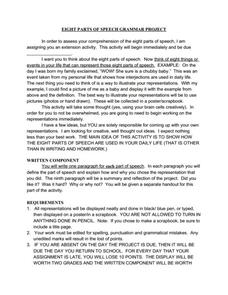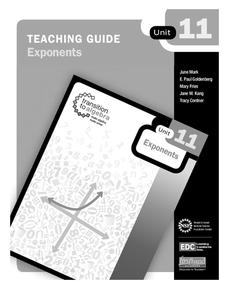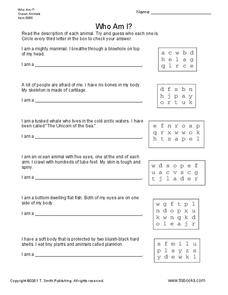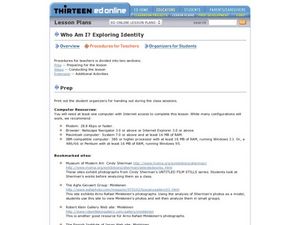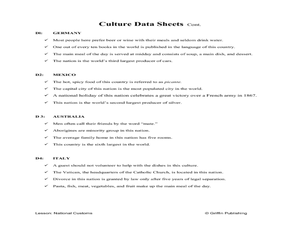National Park Service
Subalpine Web
The theory of keystone species in an ecosystem was first established in 1969 by Robert T. Paine. Pupils open the final lesson in a five-part series with a game guessing which member of the alpine ecosystem they are based on clues. After...
K12 Reader
Character Development in "The Tell-Tale Heart"
Yes. Make up your mind to use this reading comprehension resource with your readers. You need not be nervous, not even a little nervous. An answer sheet is provided.
Curated OER
Directions Test
Have your pupils really been reading the directions? Find out with this tricky little test. The first instruction is to read all of the directions quickly, but you'll find that quite a few pupils start acting rather funny just a few...
Wild BC
Carbon Sinks and Sources
Earth or environmental science pupils are assigned to be carbon sources or sinks. They ask yes-or-no questions to try to figure out which one they are. Then they discuss ways people can have positive effects on the changing climate by...
Houghton Mifflin Harcourt
Wheels Go Around: English Language Development Lessons (Theme 7)
Wheels go around is the theme of the plethora of activities to aid in the language fluency of your scholars in this unit of ESL lessons. Learners can take part in a grand conversation focused on wheels, make their own steering wheel,...
Houghton Mifflin Harcourt
Surprise!: English Language Development Lessons (Theme 2)
Surprise! is the theme of this series of ESL lessons. Cover an array of topics such as where we live, different times of day, shapes, the city and the country, what we do for fun, jobs, and games, all while practicing how to express...
Houghton Mifflin Harcourt
A World of Animals: Extra Support Lessons (Theme 10)
Provide extra support with this collection of animal-themed lessons. Early readers gain proficiency in high frequency words are and he, practice blending short vowel sounds, and substitute initial and final phonemes while creating...
Curated OER
Common Homonym Errors Worksheet
If you're unsure of your homonyms, then this learning exercise is for you. So much better than some, there are two columns of exercises, and they're fun too.
Southern Illinois University
I Can Write a Poem
It is so important for English language learners to be able to write for a variety of purposes. Specifically written for an ELD class, this activity provides explicit instruction for teaching learners how to write a poem. First, they...
Curated OER
Intelligence in the Internet Age
Does technology affect our intelligence? Stefanie Olsen's article, "Intelligence in the Internet Age," and the thought provoking reading comprehension questions that follow, are sure to generate a lively discussion.
Independence Middle School
Eight Parts of Speech Grammar Project
Young grammarians demonstrate their understanding of the eight parts of speech by creating a scrapbook that uses personal stories and photos to illustrate each term. After defining a term, individuals relate and illustrate a personal...
University of Kentucky
Bullying Awareness
As a teacher, it's likely you're seeing bullying at your school in some capacity. Use three activities as a refresher course for junior high schoolers on what bullying is, the severity of its consequences, and how they can make a...
LearnEnglishFeelGood.com
Commonly Confused Words
Test your scholars' knowledge of commonly confused words with this grammar worksheet. With multiple choice and fill-in-the-blank options, this ten question activity is certain to express your learners' understanding.
Geography 360°
Exponents
Don't let the rules overrule the lesson. Mental math steps in and helps learners understand exponent patterns. The material focuses on the introductory problems of exponents, such as simplifying expressions. Teacher guides are...
Judicial Learning Center
Your 4th Amendment Rights
Americans love to learn about their rights, especially those that protect them from the government's power to invade their privacy. Young people are especially engaged by this topic. An informative lesson explores four Supreme Court...
It's About Time
Present-Day Climate in Your Community
So what exactly is climate? This first installment of a six-part series introduces the concept of climate using real-world data tables and topographic maps. The timely lesson includes a comprehensive overview of climate, as well as...
Wordpress
Notes on Romeo and Juliet – Act 2
If your purpose in using Romeo and Juliet with your classes is to share enjoyment rather than to just read the play by rote, come and inspect these materials designed for the scenes in Act II of Shakespeare's tale of star-crossed lovers.
Pearson
Non-Action Verbs
A verb is something you do — but can you always see the action? Use a slideshow presentation to clarify the differences between verbs that describe actions, and verbs that describe senses, preferences, and emotions.
Seussville
A Classic in 236 Words
Get in the reading spirit on Read Across America Day while celebrating Dr. Seuss' birthday with four printable worksheet activities. Included is a word search using story character's names, a quiz to test how many Dr. Seuss titles you've...
Curated OER
What Am I?
In this food worksheet, students are given clues to different kinds of food and they need to guess what it is. Students are given clues to 10 different foods.
Curated OER
Who Am I?
For this earth science worksheet, students read the description of each animal and identify who each one is. They circle every third letter in the box to the right to check their answer.
Curated OER
Who Am I?
In this early childhood shape problem solving worksheet, students determine the 4 shapes that are described. Student also respond to 1 short answer question.
Curated OER
Who Am I? Exploring Identity
Students define identity, consider who they are/what they value, explore the work of two photographers featured on an upcoming episode of EGG THE ARTS SHOW to see how they have dealt with the issue of identity, and respond using...
Curated OER
Where Am I? Map Activity
In this map activity worksheet, students determine which countries are shown on a set of 16 maps, then read facts about each country designed to help with a report on that country.












